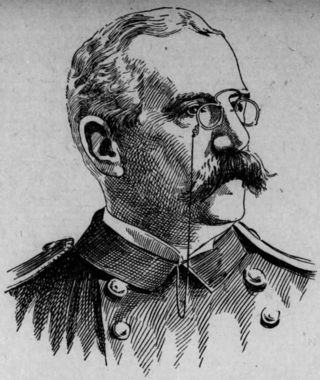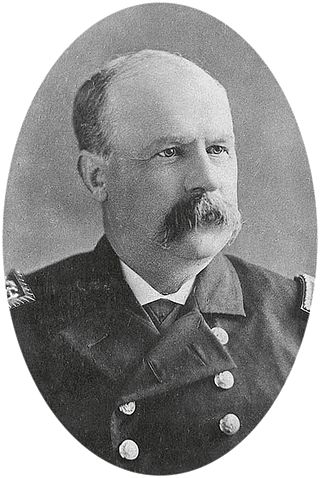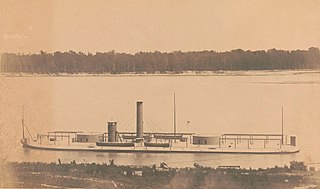
David Glasgow Farragut was a flag officer of the United States Navy during the American Civil War. He was the first rear admiral, vice admiral, and admiral in the United States Navy. He is remembered for his order at the Battle of Mobile Bay, usually paraphrased as "Damn the torpedoes, full speed ahead" in U.S. Navy tradition.

George Dewey was Admiral of the Navy, the only person in United States history to have attained that rank. He is best known for his victory at the Battle of Manila Bay during the Spanish–American War, with the loss of only a single crewman on the American side.

Daniel Chester French was an American sculptor of the late nineteenth and early twentieth centuries. He is best known for his 1874 sculpture The Minute Man in Concord, Massachusetts, and his 1920 monumental statue of Abraham Lincoln in the Lincoln Memorial in Washington, D.C.

USS Brooklyn was a sloop-of-war authorized by the U.S. Congress and commissioned in 1859. Brooklyn was active in Caribbean operations until the start of the American Civil War at which time she became an active participant in the Union blockade of the Confederate States of America.
The first USS Arizona was an iron-hulled, side-wheel merchant steamship. Seized by the Confederate States of America in 1862 during the American Civil War, she was captured later the same year by the United States Navy.

Nehemiah Mayo Dyer was a rear admiral in United States Navy, who served during the American Civil War and Spanish–American War. He was one of the few individuals to have served in both the Battle of Mobile Bay during the Civil War and the Battle of Manila Bay during the Spanish–American War.

The Battle of Mobile Bay of August 5, 1864, was a naval and land engagement of the American Civil War in which a Union fleet commanded by Rear Admiral David G. Farragut, assisted by a contingent of soldiers, attacked a smaller Confederate fleet led by Admiral Franklin Buchanan and three forts that guarded the entrance to Mobile Bay: Morgan, Gaines and Powell. Farragut's perhaps apocryphal order of "Damn the torpedoes! Four bells. Captain Drayton, go ahead! Jouett, full speed!" became famous in paraphrase, as "Damn the torpedoes, full speed ahead!"

USS Hartford, a sloop-of-war steamer, was the first ship of the United States Navy named for Hartford, the capital of Connecticut. Hartford served in several prominent campaigns in the American Civil War as the flagship of David G. Farragut, most notably the Battle of Mobile Bay in 1864. She survived until 1956, when she sank awaiting restoration at Norfolk, Virginia.

Commodore George Hamilton Perkins was an officer in the United States Navy during the American Civil War.

USS Richmond was a wooden steam sloop in the United States Navy during the American Civil War.

USS Sciota was a Unadilla-class gunboat built on behalf of the United States Navy for service during the Civil War. She was outfitted as a gunboat, with both a 20-pounder rifle for horizontal firing, and two howitzers for shore bombardment, and assigned to the Union blockade of the waterways of the Confederate States of America.

USS Chickasaw was an ironclad Milwaukee-class river monitor built for the United States Navy during the American Civil War. The ship participated in the Battle of Mobile Bay in August 1864, during which she was lightly damaged, and the bombardments of Forts Gaines and Morgan as Union troops besieged the fortifications defending the bay. In March–April 1865, Chickasaw again supported Union forces during the Mobile Campaign as they attacked Confederate fortifications defending the city of Mobile, Alabama.

The first USS Ossipee was a wooden, screw sloop-of-war in commission in the United States Navy at various times between 1861 and 1889. She served in the Union Navy during the American Civil War. She was named for the Ossipee River of New Hampshire and Maine. The USS Ossipee was present during the Alaska Purchase.
USS Henry Janes was a mortar schooner acquired by the United States Navy during the American Civil War. She was used as a gunboat and assigned to the blockade of ports of the Confederate States of America.

David Dixon Porter was a United States Navy admiral and a member of one of the most distinguished families in the history of the U.S. Navy. Promoted as the second U.S. Navy officer ever to attain the rank of admiral, after his adoptive brother David G. Farragut, Porter helped improve the Navy as the Superintendent of the U.S. Naval Academy after significant service in the American Civil War.

USS John P. Jackson was a sidewheel steamer acquired by the Union Navy during the beginning of the American Civil War. Built in 1860, John P. Jackson was used as a ferry by the New Jersey Rail Road and Transportation Company. In February 1861, she ferried president-elect Abraham Lincoln on his way to his inauguration. She was purchased for use in the American Civil War on 6 November. Commissioned for military service on 14 February 1862, she was sent to Ship Island. On 4 April, she was part of a battle with Confederate vessels near Pass Christian, Mississippi. That same day she captured the blockade runner P. C. Wallis. In April, she bombarded Confederate-held Fort Jackson and Fort St. Philip. The next month, John P. Jackson participated in a scout of Lake Pontchartrain.

USS Octorara was a steamer acquired by the Union Navy during the American Civil War. She was used by the Navy to patrol navigable waterways of the Confederacy to prevent the Confederates from trading with other countries.
USS George Mangham was a schooner acquired by the Union Navy during the American Civil War. She was used by the Union Navy as a gunboat in support of the Union Navy blockade of Confederate waterways.

The Dewey Monument is a memorial statue by Robert Ingersoll Aitken in San Francisco, California, located at the center of Union Square. Union Square is bounded by Geary, Powell, Post and Stockton Streets. The monument is dedicated to Admiral George Dewey and commemorates his victory in the Battle of Manila Bay during the Spanish–American War. Work on the monument began in 1901 and it was dedicated in 1903.

Admiral David Glasgow Farragut, also known as the Admiral Farragut Monument, is an outdoor bronze statue of David Farragut by Augustus Saint-Gaudens on a stone sculptural exedra designed by the architect Stanford White, installed in Manhattan's Madison Square, in the U.S. state of New York.



















